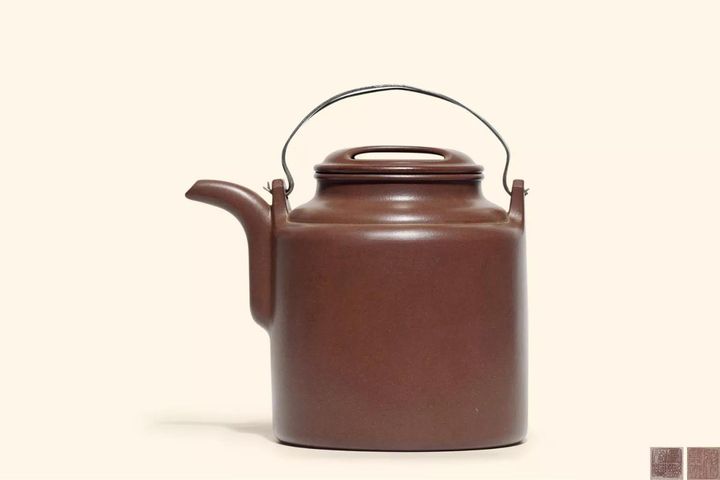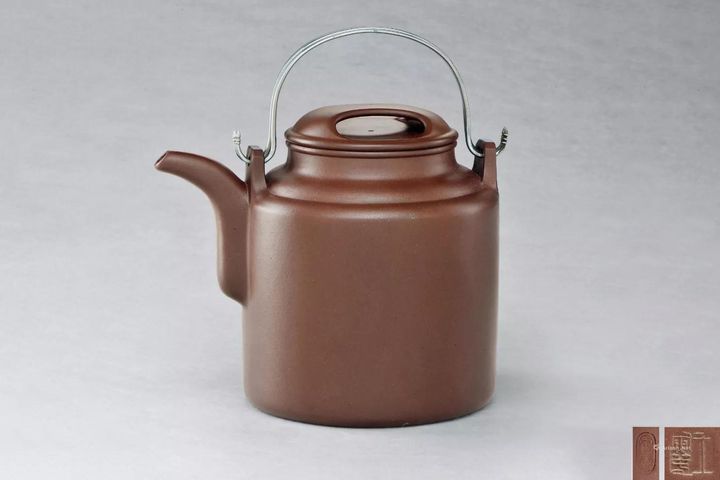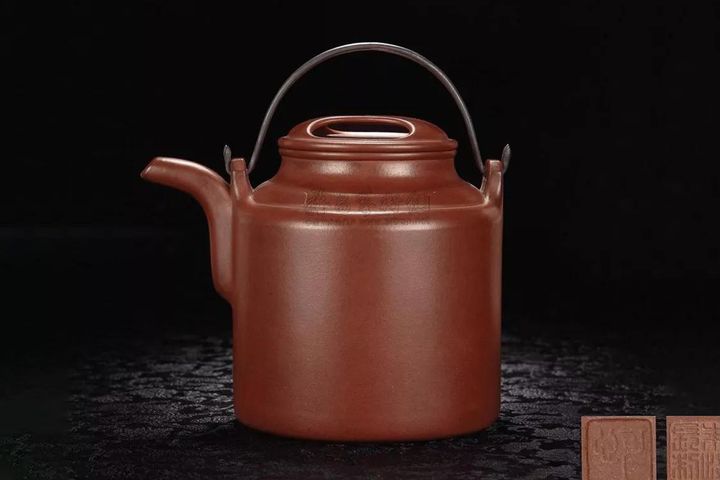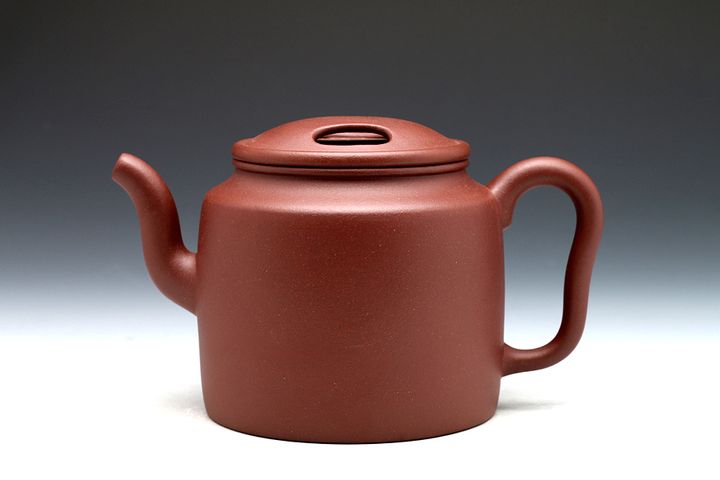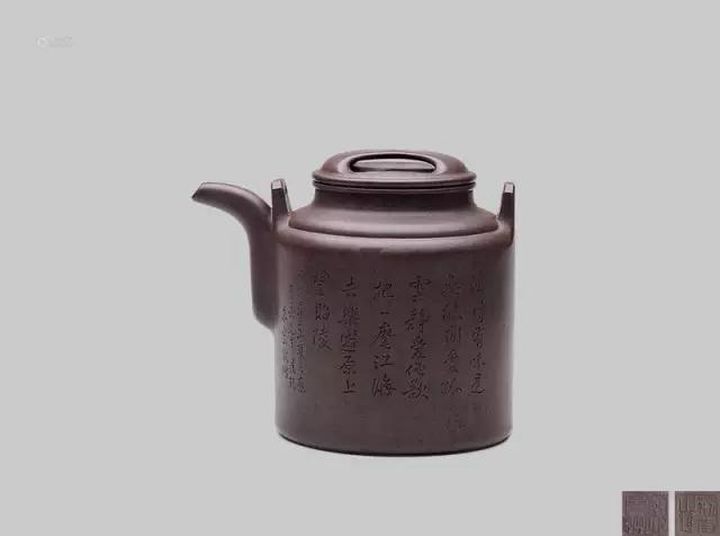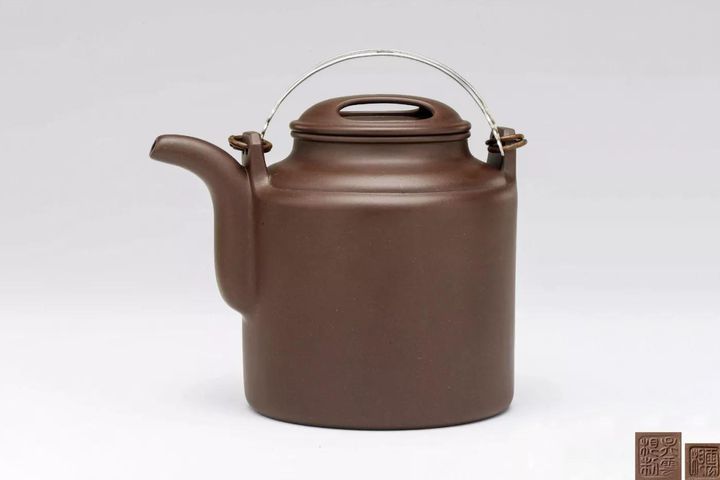Yantong Teapot Shape (Foreign Teapot)
One of the most common types of purple clay teapots. It features simple design, ease of use and portability, combining beauty and practicality. This type of teapot is beloved and collected by many purple clay pottery enthusiasts, becoming a classic work of art in traditional ceramics.
The Yantong teapot was created during the late Qing Dynasty (Chinese: 清末, pinyin: Qīng mò) of the early Republic of China (Chinese: 民初, pinyin: Mín chū). The name "Foreign" (Chinese: 洋, pinyin: Yáng) refers to the fact that it was originally intended for export.
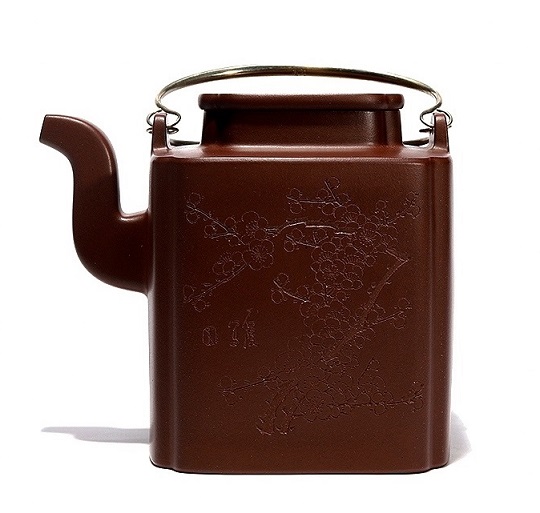
A square purple clay teapot made by Wang Xiujiu (王秀局, Wáng xiùjú) and engraved by Xu Weiguo (许卫国, Xǔ wèiguó)
The Foreign Purple Clay Teapot is a classic model among traditional purple clay products, and is a benchmark for craftsmen. This work of art was created by Wang Xiujiu (Chinese: 王秀局, pinyin: Wáng xiùjú) and engraved by Xu Weiguo (Chinese: 许卫国, pinyin: Xǔ wèiguó). The product is charming in its simplicity and elegance, combining smooth lines in shape and graceful surfaces.
At that time, for tea houses, tea masters and collectors, Yantong teapots were not only the best choice for everyday use, but also valuable works of art. Handcrafted by famous artists and craftsmen, purple clay teapots have always attracted the attention of collectors and tea ceremony experts. A foreign teapot will decorate any collection.
Many great masters and famous artists have created Yangtong teapots from purple clay in their time, including master Gu Jingzhou (Chinese: 顾景舟, pinyin: Gù jǐng zhōu).
This purple clay teapot has a long oval body and a refined look typical of the purple clay style. This shape makes it impossible to hide imperfections, so it is both a good model for a beginner and a serious test of skill for an experienced craftsman.
This teapot was created by master Chu Ming (Chinese: 储铭, pinyin Chǔ míng), who was once a guest teacher of the Gu Jingzhou family and was known as the “King of Yantong-shaped teapots” (Chinese: 洋桶壶王, pinyin Yángtǒng hú wáng).
His purple clay pieces are characterized by straight lines and smooth surfaces, a light, airy body, a tight, gap-free lid and a distinctive rounded style.
The Yantong Teapot was the first famous work of Gu Jingzhou in the early period. It inherited the straightforwardness and clarity of structure, and the author infused it with the spirit of rigidity and skill.
This teapot has always been considered a classic example, setting standards in lines, workmanship and character.
From the end of the Republic of China to the beginning of the modern period and up to the present day, the development and prosperity of purple clay in various stages led to the emergence of various forms of purple clay teapots. However, the shape of the foreign teapot has remained virtually unchanged, always remaining popular due to its portability and practicality, becoming everyday utensils in many families.
At one point in history, the foreign purple clay teapot was one of the most popular types among tea lovers and one of the most widely used accessories for brewing the drink.
Why is the Yantong teapot called so? We are used to calling goods brought from abroad "foreign" (Chinese: 洋货, pinyin: Yáng Huò), such as matches (Chinese: 洋火, pinyin: Yáng huǒ), wine (Chinese: 洋酒, pinyin: Yángjiǔ), etc. Could this teapot have been brought to China from the West? In fact, the teapot was originally created for foreigners. Its origin is related to the following three versions.
The first version: export to Southeast Asia (Chinese: 南洋外, pinyin: Nányáng wài). According to historical sources, the 7th to 16th years of the reign of Emperor Guangxu (Chinese: 光绪, pinyin: Guāngxù) were the periods when purple clay collection became popular in China. They were in demand not only within the country, but also in Japan, Indonesia, Malaysia, the Philippines, Singapore, Thailand, the United Kingdom, France and other countries. In order to meet the needs of overseas customers, craftsmen made teapot shapes according to the requirements of foreign buyers. The original type had a single push-button tap and was polished and framed with a copper rim according to the requirements of customers from Thailand. Foreign teapots were actively sold to Southeast Asian countries, particularly Thailand, which is why they got their name "foreign".
The second version: Export to East Asia (Chinese: 东洋外, pinyin: Dōngyáng wài). In the late Qing Dynasty, the popularity of Yixing pottery (宜兴, Yíxìng) was widespread, and Japanese merchants began to take an interest in it. The potter He Shiwei (Chinese: 何士为, pinyin: Hé shìwéi) took the design of the Small Altar (Chinese: 小洋坛, pinyin: Xiǎoyáng tán) from Yixing City (宜兴, Yíxìng) as a basis and modified its shape by increasing the size and length of the handle. Thus, a foreign teapot with a hinged lid and a rough style was created. This piece aroused great interest and was actively ordered by Japanese merchants. Japan was known as the Orient (Chinese: 东洋, pinyin Dōng yáng), so the teapot was named "Foreign".
The third version: export to Beiyang (Chinese: 北洋, pinyin: Běiyáng). In the late Qing Dynasty, popular pottery shapes were the Egg Bun Teapot (Chinese: 蛋包, pinyin: Dànbāo) and the Longevity Teapot (Chinese: 寿星, pinyin: Shòu xing). These two teapots had a round body, flat lid, and clear functionality, which made them popular and widespread. They were sold to Japan and other Southeast Asian countries. Therefore, the "foreign" teapot, created based on the lid shape of the Longevity Teapot and the Egg Bun Teapot, was named "Foreign" with a flat lid.
Although there are three different theories regarding the origin of Yantong teapots, they all agree on one thing - these teapots were probably created in the late Qing Dynasty of China, although in different sequences. According to historical sources, one of the early terms associated with this style was "Single-handled teapot" (Chinese: 独钮洋桶, pinyin: Dú niǔ yáng tǒng). "A Brief History of Yixing Pottery" (Chinese: 宜兴陶瓷简史, pinyin: Yíxìng táocí jiǎn shǐ), "Chinese Chronicles of Jiangsu Province.
The Chronicle of the Ceramic Industry (Chinese: 江苏省志.陶瓷工业志, pinyin: Jiāngsū shěngzhì: Táocí gōngyè zhì) and the Chronicle of Yixing County (Chinese: 宜兴县志, pinyin: Yíxìng xiànzhì) also state that the term first appeared in the description of export teapots during the Guangxu Dynasty (Chinese: 光绪, pinyin: Guāngxù), but is absent from other records. However, existing single-handle teapots exported to other countries also match these historical records. The next style of product was probably the Yangtong teapot with an ox-head lid. The lid resembles the "egg bun" of Yixing, where the lid has no clear edge and the nose of the lid has a projection resembling the eyes of a bull. This style is a classic example of teapot style and, according to the analysis of collectors and researchers, was created in the early Guangxu period and shows the typical style of clay teapots of that time.
Researchers have repeatedly discussed with collectors about the origin, and came to the conclusion that it was one of the earliest styles created in the late Qing Dynasty, confirmed by historical facts. Immediately after the appearance of the "ox-head lid teapot", the "flat-lid teapot" was created. The reason is that the "ox-head lid teapot" was created based on the "Longevity" teapot, and the "Longevity" teapot and the single-handle teapot are mentioned at the same time in the "Brief History of Yixing Pottery", "Chronicles of Jiangsu Province", "Chronicles of the Ceramic Industry", "Chronicles of Yixing County". Therefore, it is assumed that the "flat-lid teapot" appeared after the "ox-head lid teapot".
Although this teapot has a foreign name, it has left a unique and vivid memory in the hearts of Chinese people. In the late Qing Dynasty and early Republic of China, there were many teahouses in urban and rural areas of Yixing, with more than seventy teahouses in four major cities alone. People of all walks of life, from farmers to pack cart sellers, would carry their teapots to the teahouses even before dawn. The teapots were packed in boxes, carried in baskets, and carried in hands, and they were all Yantong teapots. Over time, as tea customs and preferences changed, this shape of teapot was sought after as a high-end artistic teapot for a certain period, and was sold to collectors at high prices. For example, in the 1940s, Gu Jingzhou created his famous Yantong teapot, which brought him recognition in the industry. At that time, the value of the old silver yuan (a unit of weight) was ten silver yuan. At that time, the average worker earned only 2-3 silver yuan per month. However, Mr. Hua Yintang (Chinese: 华荫棠, pinyin: Huá yīntáng), a collector and lover of purple clay pottery, spared no expense in purchasing two Yantong teapots from master Gu Jingzhou. This incident has become a legend in the world of purple clay pottery.
With the decline of teahouse culture, changes in tea habits and taste preferences, Yantong teapots have once again become a commodity for mass consumption and are no longer sought after by collectors. However, it cannot be denied that at certain periods in history, they were an indicator of the artist's skill and have long been considered works of art by tea connoisseurs.
A tour of the history of the creation of teapots of this shape allowed us to return to the past, to immerse ourselves in the atmosphere of old tea houses. Imagine wooden chairs, tables and loud hubbub. Waiters carry teapots from table to table. Customers sitting around prepare tea in large teapots and pour it into cups with lids, play cards and chess, chatting about all sorts of things.
Sometimes there were old men with bird cages. Despite the changeable weather outside, there was always peace and tranquility inside the teahouse. These memories are like a hidden white dragon, and the "foreign" teapots in teahouses seem like ancient history. Remembering the past is not only the transmission of classical traditions, but also the preservation of cultural heritage.
Source
- Комментарии
- Вконтакте





